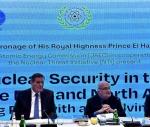You are here
‘The man who discovered how we see’: Ibn Al Haytham exhibition opens
By Dana Al Emam - Mar 08,2017 - Last updated at Mar 08,2017

An exhibit on display on Wednesday at the Jordan Museum as part of ‘Ibn Al Haytham: Exhibition on the Man Who Discovered How We See’ (Photo by Dana Al Emam)
AMMAN — The Jordan Year of Science (JYS) 2017 kicked off on Wednesday with the opening of an exhibition on 11th century Arab scientist Ibn Al Haytham at the Jordan Museum.
Dubbed “Ibn Al Haytham: Exhibition on the Man Who Discovered How We See”, the exhibition introduces the pioneering scientist and his major contributions to the science of light and vision, through entertaining, educational content, according to organisers.
Speaking at the opening event, HRH Princess Sumaya, president of the Royal Scientific Society (RSS) and vice chair of the Jordan Museum, said the exhibition is a catalyst for school students to delve into scientific research and to deepen their trust and understanding of their Arab and Islamic culture.
She cited the Ministry of Education as a “strategic” partner that helped to promote the exhibition, which is “a cultural and scientific portal and an advanced, non-traditional learning method”.
The exhibition, the princess said, is a first step in the JYS, organised by the RSS, adding that Jordan’s hosting of the World Science Forum in November this year under the “Science for Peace” theme is a bid to enhance the role of science in peace building.
The forum will see the participation of some 3,000 scientists and thinkers from over 100 countries, she noted.
The launch event was held under the patronage of Education Minister Omar Razzaz, and was attended by several officials, scientists and academics.
The exhibition, which is produced by the Britain-based organisation 1001 Inventions, also celebrates the renowned Arab scientist as part of Amman’s selection as the capital of Islamic culture for 2017.
Ibn Al Haytham, who lived between the years 965 and 1040, excelled in numerous fields, including astronomy, optics and mathematics.
He is considered an early pioneer of theoretical physics and the first person to explain how vision works through an object’s reflection of light to the eye.
His methodology of investigation, in particular using experiments to verify theories, shows certain similarities to what later became known as the modern scientific method, according to organisers.
A Jordan Museum statement quoted Ahmad Salim, producer and director of 1001 Innovations, as saying that Ibn Al Haytham’s inspirational life and his contributions to the world are important to recognise.
“He lived during a golden age of discovery and creativity in Muslim civilisation, where men and women of different faiths and cultures achieved breakthroughs that influence the world today,” he said.
The month-long exhibition will be open to the public daily, except Tuesdays, from 9am to 5pm and on Fridays from 2pm to 6pm.
Established in 2013, the Jordan Museum aims to document, conserve and present Jordan’s archaeological and cultural heritage, Ihab Amarin, the museum’s director general, told The Jordan Times in a recent interview.
He added that the 10,000-square-metre building consists of showrooms that exhibit nearly 1,000 pieces, while around 2,500 others are kept in storage.
















